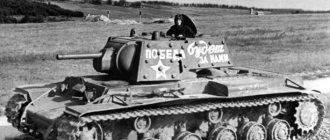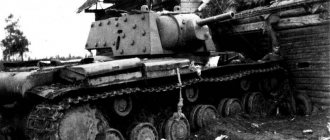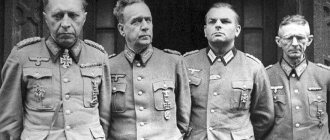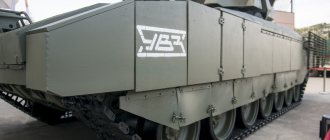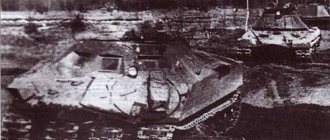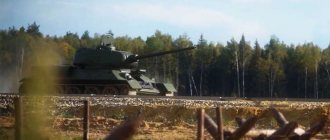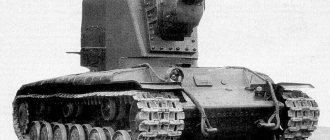Events of August 19, 1941
Zinoviy Grigorievich Kolobanov
At the end of August 1941, Kolobanov’s 3rd tank company defended the approaches to Leningrad in the area of the city of Krasnogvardeisk (now Gatchina). Every day, every hour was “worth its weight in gold” - military enterprises and civilians were evacuated from the northern capital. The tank company the day before was replenished with new KV-1 tanks with crews arriving from Leningrad. The commander of the 3rd tank company of the 1st tank battalion, senior lieutenant Zinoviy Kolobanov, was summoned to the division commander, General Baranov, from whom he personally received an order to cover three roads leading to Krasnogvardeysk from Luga, Volosovo and Kingisepp (via the Tallinn highway):
Block them and fight to the death!
block three roads that lead to the city from Luga, Volosovo and Kingisepp. Protect three roads with five tanks” - only he could cope with this. By that time, the tanker had gone through the Finnish war, burned in the tank three times, but each time returned to duty.
On the same day, Kolobanov’s company of five KV-1 tanks advanced to meet the advancing enemy. It was important not to miss the German tanks, so each tank was loaded with two rounds of armor-piercing shells and a minimum amount of high-explosive fragmentation shells.
According to the research of O. Skvortsov, events developed as follows. Having assessed the likely routes of movement of the German troops, Kolobanov sent two tanks to the Luga road, two to the Kingisepp road, and he himself took a position on the coastal road. The tank trench for the KV-1 heavy tank No. 864 of Senior Lieutenant Zinovy Kolobanov was built just 300 meters opposite the T-shaped intersection in such a way as to fire “head-on” if the tanks took the first route. On both sides of the road there was a swampy meadow, which made it difficult for German armored vehicles to maneuver.
Scheme of the battle between KV senior lieutenant Z. Kolobanov and a German tank column on August 19, 1941
Events of August 20, 1941
The next day - August 20, 1941, in the afternoon, the crews of Lieutenant Evdokimenko and Junior Lieutenant Degtyar were the first to meet a German tank column on the Luga Highway, chalking up five enemy tanks and three armored personnel carriers. Then, at about 14:00, after an unsuccessful aerial reconnaissance, German reconnaissance motorcyclists followed along the seaside road to the Voyskovitsy state farm, whom Kolobanov’s crew let through without hindrance, waiting for the main enemy forces to approach. Light German tanks (presumably Pz.Kpfw.35(t)) were moving in the column. After waiting until the lead German tank of the column reached two birch trees on the road (“Landmark No. 1”), Kolobanov commanded: “Landmark first, at the head, direct shot under the cross, armor-piercing - fire! After the first shots from gun commander Usov, a former professional artillery instructor and participant in the war in Poland and Finland, the three lead German tanks caught fire, blocking the road. Then Usov transferred the fire to the tail, and then to), thereby depriving the enemy of the opportunity to move back or towards Voyskovich. (According to other information published in the newspaper “St. Petersburg Diary” on September 14, 2015, three enemy tanks immediately knocked out by the first three shots of the crew of Kolobanov were located at the head, tail and in the middle of the column)
On a narrow road, on both sides of which there was a swamp, a crush formed: cars, continuing to move, bumped into each other, moved to the side of the road and ended up in the swamp, where they completely lost mobility and could only fire from the towers. The ammunition in the burning enemy tanks began to explode. The German tank crews returned fire, and even all the enemy tanks stuck in the swamp had to be suppressed by fire. 114 German shells hit the turret of Kolobanov’s tank. But the armor of the KV turret has proven itself from the best side.
In 30 minutes of battle, Zinovy Kolobanov’s crew knocked out all 22 German tanks in the column. 98 armor-piercing shells were used from the double ammunition load.
According to some evidence, along with the command of the tank unit, a “special” correspondent for the Izvestia newspaper, a staff correspondent for the local militia newspaper “For the Defense of Leningrad,” Pavel Maisky, also came to the battlefield. By order of Divisional Commander V.I. Baranov, the crew occupied the second prepared tank trench in anticipation of a second attack. Apparently, this time the tank was discovered, and the Pz.Kpfw.IV fire support tanks began firing at the KV-1 from a long distance in order to divert attention to themselves and not allow targeted fire on the tanks and motorized infantry that were breaking through at that time to the area of the educational farm and further to Chernovo. In addition, they needed to force the Soviet tank crews to leave their position in order to begin evacuating the damaged tanks. The tank duel did not bring results to both sides: Kolobanov did not report a single tank destroyed at this stage of the battle, and his tank’s external surveillance devices were broken and the turret jammed. He even had to give the command to leave the tank trench and turn the tank around in order to aim the gun at the German anti-tank guns, which were brought to close range to the tank during the battle. However, Kolobanov’s crew completed the task, engaging in battle the German Pz.Kpfw.IV fire support tanks, which were unable to support the advance of the second tank company into the Soviet defense, where it was destroyed by a group of KV-1 tanks under the command of battalion commander Shpiller.
After the battle, more than a hundred hits were counted on Kolobanov’s KV-1. Thus, 22 German tanks were knocked out, and in total his company chalked up 43 enemy tanks
(including the crew of junior lieutenant F. Sergeev - 8; junior lieutenant V. I. Lastochkin - 4; junior lieutenant I. A. Degtyar - 4; lieutenant M. I. Evdokimenko - 5).
In addition, battalion commander Shpiller personally burned two tanks. On the same day, the company destroyed: one passenger car, an artillery battery, up to two companies of infantry, and one enemy motorcyclist was captured. Kolobanov about the military battle: “...I was often asked: was it scary? But I am a military man, I received an order to fight to the death. This means that the enemy can only pass through my position when I am no longer alive. I accepted the order for execution, and I no longer had any “fears” and could not arise. I regret that I cannot describe the battle sequentially. After all, the commander sees first of all the crosshairs of the sight. ... Everything else is just explosions and the shouts of my guys: “Hurray!”, “It’s on fire!” The sense of time was completely lost. I had no idea how long the battle was going on.”
Crew of Zinovy Grigorievich Kolobanov
Immediately after this tank battle, which ended in the complete victory of Soviet weapons, a note about the feat of tanker Kolobanov appeared in the Krasnaya Zvezda newspaper. And in the archives of the Ministry of Defense a unique document has been preserved - the award sheet of Zinovy Kolobanov. Kolobanov received the Order of the Red Banner on February 3, 1942. The rest of the crew - the gun commander, senior sergeant A. M. Usov, was awarded the Order of Lenin, the driver mechanic, sergeant major N. I. Nikiforov, was awarded the Order of the Red Banner, the gunner-radio operator, senior sergeant P. I. Kiselkov and the loader of the Red Army, N. F. Rodenkov - Order of the Red Star.
All members of the tank crew were nominated by regiment commander Pogodin for the title of Hero of the Soviet Union, but not a single one received the title
The issue of awarding Zinoviy Grigorievich Kolobanov the highest award of Russia - Hero of the Russian Federation - was initiated by Vasily Monich, who, at his own expense, erected a memorial monument to the tankman at the Chizhovsky cemetery in Minsk in 2006. This issue was raised repeatedly and to no avail by various veteran organizations; once again in June 2011, the Legislative Assembly of St. Petersburg made a request to assist in awarding Lieutenant Colonel Z. G. Kolobanov the title of Hero of the Russian Federation (posthumously) on July 15, 2011, the head of the Main Personnel Directorate of the Ministry of Defense Colonel General V.P. Goremykin refused to award Zinovy Kolobanov the title of Hero of Russia, considering the award inappropriate.
- In the early 1970s, at the Belarusfilm film studio, for the 30th anniversary of the Victory, they planned to shoot a documentary about the brave front-line tankman, but the film studio abandoned its plan. According to director Igor Dobrolyubov, they simply didn’t believe in Kolobanov’s feat.
- On the eve of Tankman's Day on September 8, 1983, at the site of the military battle, in the area of Uchkhoz "Voyskovitsy", a memorial was opened - the IS-2 tank monument. Among the tank veterans present at the opening of the memorial were direct participants in the battle, crew members Z. G. Kolobanov, A. M. Usov, and political instructor V. K. Skorospekhov.
- In 2006, in the Krasnoselsky district of St. Petersburg, Kolobanovskaya Street, passing through the sites of former battles in Gorelovo, was named in honor of the legendary tanker.
- Over the grave of Z. G. Kolobanov at the Chizhovsky cemetery in Minsk, a memorial monument was erected to him with a story about the battle near Voyskovitsy. Students of the Minsk Suvorov Military School are patronizing the grave
Alexander Gitovich. Tank driver Zinoviy Kolobanov
It all went like this: A heavy tank stands in stern silence, camouflaged in a fishing line.
Day - in a blue haze The branch does not move. Three tanks went into battle - German intelligence.
It's time! The fire is open! And you can see in clear light how the first tank was hit, followed by the second and third.
But straight to the forest It still turns out forty. Attention! Every moment is inexpressibly precious.
The enemies are coming in a crowd of Iron idols, But Zinoviy Kolobanov takes the fight.
He is menacing and harsh, Behind him stands the bulk of factories and gardens, and the streets of Leningrad.
And in the white light of day, from the quiet thicket of the forest of metal and fire, a curtain rises.
And through the roar of explosions, the World looks at the plain, Where the senior lieutenant Led the car into battle.
He fights the enemy in a lead hurricane, smashing some with fire, ramming others at point-blank range.
He beats enemies in a row Like an epic hero, Wrecked cars lie around him.
There are already twenty-two of them, scattered by a storm, they lie in the grass like fragments of metal.
The course of the battle is over, with the last salvo bursting out, and Zinovy Kolobanov gives the report.
1 of 12
What was the fate of Kolobanov’s tankers?
There is no complete data on the fate of the Soviet tank crews who participated in the battle near Voyskovitsy. The names of most of the heroes were simply forgotten - information about them was lost in the paper cycle of the wartime. The weekly Zvezda tried to collect at least some information bit by bit.
Kolobanov's crew
- Commander. Shortly after the battle near Voyskovitsy, on September 15, 1941, Zinoviy Kolobanov was seriously wounded. But after a long treatment he managed to return to duty, fought again and continued his military career after the war. With the rank of lieutenant colonel, he was transferred to the reserve on July 5, 1958. Lived in Belarus, worked at the Minsk Automobile Plant.
- Gunner. Finding the biography of Senior Sergeant Andrei Mikhailovich Usov was not so easy. But his memories have been preserved, which contain the following words: “Although the enemy shells did not penetrate the armor of our KV, they made such a roar that it seemed as if they were hitting the head with a sledgehammer.” Andrei Mikhailovich escaped particularly serious wounds; he went through the entire war. In 1946, he was demobilized from the army and returned to his native Tolochin, joined the party, became the second secretary of the Tolochin district committee of the CPSU, and after 1954 - director of the Tolochin oil depot.
- Driver mechanic. Even less is known about Sergeant Major Nikolai Ivanovich Nikiforov. However, there is information that he also went through the entire war. By the way, he distinguished himself again the very next day after the battle at Voyskovich. The crew knocked out a German motorcycle, and the foreman was sent to take the tongue. Under fire, Nikolai Ivanovich got to the motorcycle, but the German was already dead, but the foreman got important documents. After the end of the war, Nikiforov continued to serve in the army, trained young tank crews, and passed on combat experience
- Radio operator. Senior Sergeant Pavel Ivanovich Kiselkov died on the Nevsky Pyochka almost immediately after the commander was wounded.
- Charging. The last line in the biography of driver Nikolai Feoktistovich Rodnikov (Rodenkov) is “died near Leningrad.” But the memory of Zinovy Kolobanov has been preserved: “Kolya Rodenkov stood out in the crew for his lively, cheerful character and boundless courage. I remember when the commander’s periscope was shot down on August 19, he got out of the tank without orders under enemy fire, found the head of the device in the grass and restored the periscope.”
Evdokimenko's crew
- Commander. The commander of the tank platoon, Lieutenant Maxim Evdokimenko, died the very next day - August 21, 1941. For the battle near Voyskovitsy he was awarded posthumously.
- Driver mechanic. There is little information left about foreman Nikolai Zakharovich Sidikov. Only a description of his actions in that memorable battle, which remains in the archival documents: “The brakes refused to work. Sidikov brought the tank out of the battlefield by regulating its movement with gas.”
- Information about three more crew members could not be found.
Tar Crew
- All that is known about the crew of junior lieutenant Ivan Andreevich Degtyar is that they managed to knock out four enemy tanks in the battle on August 20, 1941.
Lastochkin's crew
- Commander. Junior Lieutenant Vasily Iosifovich Lastochkin went through almost the entire war. He died in battle on January 10, 1945.
- Driver mechanic. Petty Officer Ivan Dmitrievich Iovlev. Fate unknown
- Radio operator. Vladimir Fedorovich Melnikov was seriously wounded after the battle near Voyskovitsy. From the hospital he returned to the front. I went through the whole war. He retired with the rank of colonel. He was the chairman of the council of veterans of the 1st Red Banner Leningrad Tank Brigade. He passed away on January 7, 1981.
- The names of the loader and gunner could not be established.
Sergeev's crew
- There is no information about the crew of Fedor Sergeev. It is only known that three tank crews died in the famous battle.
Sergienko's crew
- All crew members died in the battle near Voyskovitsy.
